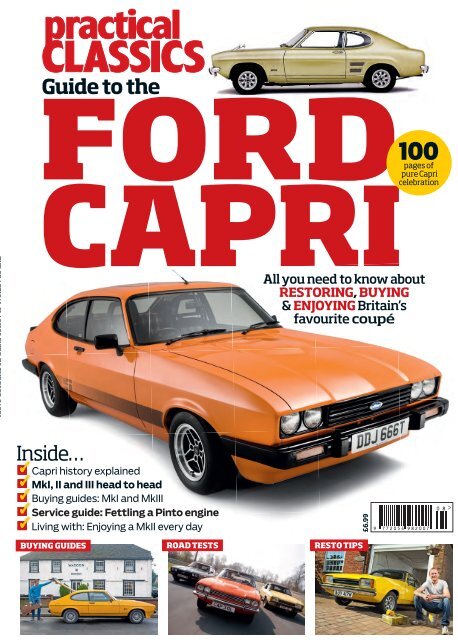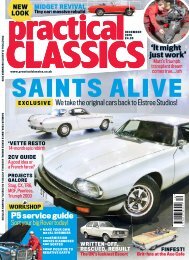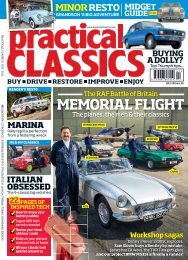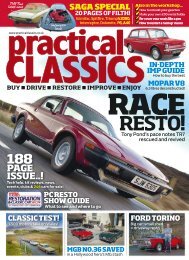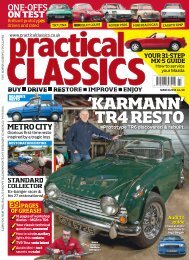Create successful ePaper yourself
Turn your PDF publications into a flip-book with our unique Google optimized e-Paper software.
Guide to the<br />
<strong>FORD</strong><br />
<strong>CAPRI</strong><br />
100<br />
pages of<br />
pure Capri<br />
celebration<br />
All you need to know about<br />
RESTORING, BUYING<br />
& ENJOYING Britain’s<br />
favourite coupé<br />
Inside…<br />
Capri history explained<br />
MkI, II and III head to head<br />
Buying guides: MkI and MkIII<br />
Service guide: Fettling a Pinto engine<br />
Living with: Enjoying a MkII every day<br />
£6.99<br />
BUYING GUIDES<br />
ROAD TESTS<br />
RESTO TIPS
Group Test<br />
Capri MkIII 280<br />
EnginE 2792cc/V6/oHC<br />
PowEr 160bhp@5700rpm<br />
TorquE 162lb ft@4200rpm<br />
gEarbox 5-speed manual<br />
ToP sPEEd 127mph<br />
0-60mPh 7.9sec<br />
mPg 21<br />
LEngTh 171.3in (4351mm)<br />
widTh 67.0in (1702mm)<br />
wEighT 2620lb (1189.5kg)<br />
LaunCh PriCE £11,999<br />
now £2000-£12000<br />
Come<br />
on then!<br />
If you think you’re hard enough<br />
The Ford Capri is a Great British icon – to decide<br />
which version is best, PC puts MkI, MkII, and MkIII<br />
through challenges that match the spirit of the car<br />
14<br />
66 <strong>FORD</strong> JAxxxxY <strong>CAPRI</strong> GUIDE 2014 2015 // PRACTICAL // PRACTICAL CLASSICS CLASSICS<br />
www.practicalclassics.co.uk
Capri 3000GT<br />
XLR<br />
EnginE 2994cc/V6/oHC<br />
PowEr 136bhp@4750rpm<br />
TorquE 181lb ft@3000rpm<br />
gEarbox 4-speed manual<br />
ToP sPEEd 115mph<br />
0-60mPh 10sec<br />
mPg 22<br />
LEngTh 167in (4232mm)<br />
widTh 64in (1626mm)<br />
wEighT 2370lb (1075kg)<br />
LaunCh PriCE £1372<br />
now £2500-£12,500<br />
Capri MkII Ghia<br />
Automatic<br />
EnginE 2994cc/V6/oHV<br />
PowEr 138bhp@5100rpm<br />
TorquE 174lb ft@3000rpm<br />
gEarbox 3-speed Ford C3<br />
auto/4-speed manual<br />
ToP sPEEd 117mph<br />
0-60mPh 10.5sec (auto)<br />
9sec (manual)<br />
mPg 18 (auto) 22 (manual)<br />
LEngTh 168.8in (4288mm)<br />
widTh 66.9in (1698mm)<br />
wEighT 2580lb (1170kg)<br />
LaunCh PriCE £2609<br />
now £2000-£12,000<br />
Photos Mark Fagelson<br />
Essex. Metaphorically and literally it’s<br />
Ford Capri country: tough, good for<br />
pulling birds and handsome from certain<br />
angles. And, of course, UK-market<br />
Capris were built there. For most Ford fans, all the<br />
range-topping MkI, II and III Capris are special cars<br />
and reside in the best segment of all – the<br />
big-engined coupé. But each of the Mks also has<br />
its diehard fans – a MkI owner will insist in the<br />
strongest possible terms that his car is the purest<br />
of the breed, as will the owner of a MkII or MkIII<br />
Capri. That’s why we felt we had to put each car<br />
through the sort of tests that really matter<br />
to any aspiring Capri owner.<br />
First, we took each variant to Brands Hatch to<br />
see which could nail the fastest lap. We checked<br />
how much fuel each car burned under stress then<br />
took a casual blast past the pillars of Essex –<br />
Barking, Basildon and Billericay. We parked up in<br />
Pitsea and counted every head turn each got with<br />
stafers Gervais Seymour, Neil Campbell and<br />
Matt Jones in arm-out-of-the-window pose mode.<br />
Finally, we headed to Tesco to see how much<br />
Stella we could fit in the boot. The tests<br />
cemented utterly non-negotiable opinions on<br />
what we thought was the best Capri. Here lies<br />
each stafer’s attempt to shamelessly flog you<br />
the car you always promised yourself.<br />
➽<br />
To subscribe to PC go to www.greatmagazines.co.uk<br />
PRACTICAL CLASSICS // <strong>FORD</strong> <strong>CAPRI</strong> GUIDE 2015<br />
15
CI5 Shootout<br />
The<br />
Profession<br />
Anarchy, terrorism, huge<br />
collars and smirks. To help<br />
combat it all we’ve assembled<br />
six special cars for a final<br />
showdown. Okay, sunshine?<br />
WORDS ANDREW ROBERTS INTERVIEWS<br />
DANNY HOPKINS PHOTOS MATT HOWELL<br />
F<br />
ifty minutes of airtime on the<br />
evening of December 30,<br />
1977, was all it took. The first<br />
episode of The Professionals<br />
redefined notions of what a British cop<br />
show could be. It was produced by Brian<br />
Clemens, the man behind The Avengers.<br />
Every script contained the words ‘malt<br />
Scotch’ and ‘sunshine’, and every edition<br />
saw William Bodie (Lewis Collins) and<br />
Ray Doyle (Martin Shaw), agents with<br />
C15 – Central Intelligence 5 – performing<br />
the finest handbrake turns and rearview<br />
mirror smirking in the history of ITV.<br />
Today we’ve drifted to a halt in the<br />
grounds of Harefield Grove Farm, CI5’s<br />
HQ in series one, and reassembled the<br />
six principal cars in The Professionals’<br />
motor pool. The show used a variety of<br />
vehicles, including Vauxhall Carltons,<br />
Datsun 180B Bluebirds and a Suzuki<br />
SJ40. But with the iconic CI5 fleet, a<br />
single, simple question remains: which<br />
is the ultimate Professionals car?<br />
➽<br />
24<br />
<strong>FORD</strong> <strong>CAPRI</strong> GUIDE 2015 // PRACTICAL CLASSICS<br />
www.practicalclassics.co.uk
ls<br />
To subscribe to PC go to www.greatmagazines.co.uk PRACTICAL CLASSICS // <strong>FORD</strong> <strong>CAPRI</strong> GUIDE 2015 25
Buying<br />
Guide<br />
SUNROOF<br />
If the car you’re<br />
viewing has a sunroof,<br />
inspect the seals<br />
thoroughly. Water ingress<br />
will quickly make a mess<br />
of the interior, if<br />
left unchecked.<br />
1978-1986<br />
Ford<br />
SILLS<br />
Many Capris<br />
were ‘treated’ to<br />
bodged sill repairs<br />
back in the day, so<br />
examine them<br />
carefully.<br />
Capri MkIII<br />
One of the all-time cult cars, Ford’s MkIII<br />
Capri ofers Seventies glamour and<br />
performance galore for all budgets<br />
I<br />
f you were asked which car was<br />
advertised as ‘the diference between<br />
driving and just motoring’ when it<br />
debuted in March 1978 you’d probably<br />
be stuck. But if you were asked which car<br />
was badged as ‘the car you always promised<br />
yourself’, you’d probably not have to think<br />
too hard. Yet both slogans belonged to the<br />
same car, albeit the famous one to the MkI<br />
Capri of 1969 and the not so famous one to<br />
the MkIII, launched in 1978.<br />
In between the two came the MkII, which<br />
was actually little diferent from the MkIII<br />
we’re looking at here, as the development of<br />
the car took less than a year to complete.<br />
Its roots lay in a concept shown at the<br />
1976 Geneva motor show called the<br />
Modular Aerodynamic, which looked like a<br />
cross between a MkII Capri and a Vauxhall<br />
Droop Snoot. The following April a<br />
development programme began using the<br />
name Carla and in March 1978 the outcome<br />
was unveiled at the Geneva show –<br />
behold, the MkIII Capri.<br />
From the outset there was no shortage of<br />
engine choices, with units ranging from a<br />
weedy (57bhp) 1298cc four-pot to a much<br />
more tasty 2994cc V6 pushing out more<br />
than double that. In between there were 1.6<br />
and 2-litre engines. The bodyshell was much<br />
like the MkII’s, the main diferences being<br />
four headlamps instead of two, along with<br />
revised bumpers, spoilers and front grille.<br />
Top of the range was the 3.0 X-pack.<br />
Within just two years of the car’s launch,<br />
special edition fever took a hold with the<br />
1600L-based GT4 being introduced and in<br />
July 1981 the Calypso and Cameo derivatives<br />
arrived in the showrooms. But the car that<br />
overshadowed these models was the 2.8i,<br />
which ousted the 3.0 models. Developed by<br />
Ford’s Special Vehicle Operations, it can be<br />
picked up for as little as £2000 and is now a<br />
fantastic value performance car.<br />
Summer 1982 saw another limited edition<br />
in the shape of the Cabaret, but when the<br />
Tickford Capri was shown at the October<br />
1982 NEC Motor Show all the other Capris<br />
paled into insignificance. Here was a Capri<br />
with a turbocharged 2.8-litre engine that<br />
‘From the outset<br />
there was no<br />
shortage of<br />
engine choices’<br />
64<br />
<strong>FORD</strong> <strong>CAPRI</strong> GUIDE 2015 // PRACTICAL CLASSICS<br />
www.practicalclassics.co.uk
WINGS<br />
Check the front<br />
wings for filler<br />
around the headlamps<br />
and also closely inspect<br />
the edge that meets<br />
up with the<br />
front doors.<br />
Mint £6000-£12,000 Average £2500-£5000 Rough £500-£1500<br />
VALANCE<br />
Road rash from<br />
stone chips can make<br />
a mess of the front<br />
valance and spoli the<br />
clean lines. Get on your<br />
hands and knees to<br />
check for this!<br />
rot, it just makes it easier to fix. Or at<br />
least it would if panels were easy<br />
to come by, but in many cases<br />
they’re not.<br />
But rust isn’t the only enemy<br />
of the Capri. Accident damage<br />
is a strong possibility, with the<br />
newest Capri now 28 years old<br />
and probably a string of owners<br />
listed on the V5. The 3-litre cars were<br />
particularly tail-happy but front end damage<br />
is the most common result of an accident<br />
you’ll have to contend with. Open the bonnet<br />
to inspect the chassis rails to make sure<br />
they’re undamaged.<br />
The most likely area to find rust lurking is<br />
the front wings, so check for filler around the<br />
headlamps and along the edge that meets<br />
the front doors. Wings are welded on and<br />
original ones are very hard to track down –<br />
if you can find one you’ll pay up to £300.<br />
Repro wings are available for £100 each,<br />
better-fitting ones costing around £175.<br />
McPherson strut Fords are renowned for<br />
rot around the strut top mountings, although<br />
the MkIII Capri isn’t as badly aficted by this<br />
as earlier cars. But it’s worth checking<br />
anyway and while you’re at it take a look at<br />
the inner wings, inside edges of the bonnet<br />
and the area around the grille. The V6 cars<br />
have a triangular strengthening plate on the<br />
underside of the inner wing, but they rot so<br />
generated a storming 205bhp, allowing<br />
it to do a genuine 140mph. Disc brakes all<br />
round were part of the package, along with<br />
a limited-slip dif and revised rear axle<br />
location to help put the power down – but it<br />
didn’t go on sale for another year.<br />
Within a few months (in January 1983) a<br />
five-speed gearbox was made standard on<br />
the 2.8i and soon after on 2-litre cars as<br />
well. By the end of 1984 the only Capris on<br />
ofer were the Laser (in 1600 form), 2.8i<br />
Special (leather trim panels, a limited-slip<br />
dif and RS spoked alloy wheels) and<br />
the Tickford Capri.<br />
The last Capri was built on December 19,<br />
1986. Like all of the final 1038 Capris it was<br />
a Brooklands 280, which meant it had<br />
leather trim, metallic green paintwork and<br />
15-inch spoked alloy wheels.<br />
Why you want one<br />
With the benefit of<br />
hindsight it’s easy to be a bit<br />
superior about the Capri<br />
MkIII. Countless gibes about<br />
flufy dice, Carlos Fandango<br />
body kits and references to<br />
the Capri being something<br />
of a Basildon Bullet have<br />
been levelled at the pretty<br />
coupé over the years but<br />
history has become much<br />
fairer over the intervening<br />
decades. As a serious and<br />
ultimately successful<br />
attempt to combine the<br />
disciplines of sports car<br />
and family transport, the<br />
MkIII deserves credit.<br />
Bodywork<br />
The Capri’s construction is incredibly simple,<br />
almost to the point of being crude in some<br />
areas. But that doesn’t stop it being prone to<br />
➽<br />
To subscribe to PC go to www.greatmagazines.co.uk<br />
PRACTICAL CLASSICS // <strong>FORD</strong> <strong>CAPRI</strong> GUIDE 2015 65
Reader’s Restoration<br />
As delivered in August 2013.<br />
Beneath the new pattern wings<br />
Chris found rust. Lots of rust.<br />
This wasn’t going to be easy…<br />
AFTER<br />
BEFORE<br />
Against<br />
the odds<br />
WORDS NEIL CAMPBELL PHOTOS MATT HOWELL<br />
Acute arthritis and a<br />
garage barely wider<br />
than his 1974 Ford<br />
Capri GT wouldn’t<br />
stop Chris Wagstaff<br />
from completing his<br />
restoration dream.<br />
Fortuna Audeces Juvat. It’s not<br />
often that we open a feature with<br />
a Latin proverb, but the<br />
translation ‘fortune favours the<br />
brave’ seemed a fitting one, especially<br />
when talking about restorer Chris<br />
Wagstaf. When he was diagnosed with<br />
chronic arthritis of the spine, aged just 29,<br />
he decided to start looking for a project.<br />
‘I figured that if I didn’t start soon I may<br />
become too ill to complete my dream of<br />
restoring a classic, so I asked Jasmin, my<br />
partner, if she thought it was a good idea,’<br />
he says. She didn’t say no thanks to being<br />
asleep at the time, so Chris began his<br />
search for the perfect classic car project<br />
to occupy him.<br />
He found this Capri 2000 GT in August<br />
2013. ‘It was on the internet for 99p ‘Buy It<br />
Now’ but the description said he wouldn’t<br />
let it go for less than ££££s, so I emailed<br />
asking what he wanted.’ Chris didn’t<br />
receive a reply, so he ofered £1000.<br />
He heard nothing back. ‘I thought ‘this is<br />
ridiculous’ so emailed again ofering<br />
£1650.’ This, combined with the assurance<br />
of instant payment and a next day<br />
collection, was enough for the reluctant<br />
vendor to phone him back.<br />
‘He wasn’t interested in the car at all. ➽<br />
70<br />
<strong>FORD</strong> <strong>CAPRI</strong> GUIDE 2015 // PRACTICAL CLASSICS<br />
www.practicalclassics.co.uk
The restorer<br />
Chris Wagstaf, 32, is a works foreman for a<br />
sealed unit window manufacturing<br />
company. He started working on<br />
cars young, helping his uncle<br />
Jim. Chris owned a string of<br />
cars before he was old<br />
enough to drive. After school<br />
he worked in garages then<br />
became an Vauxhall dealer<br />
apprentice. He’s owned around<br />
45 cars, mainly projects, but this<br />
is his first proper restoration.<br />
To subscribe to PC go to www.greatmagazines.co.uk PRACTICAL CLASSICS // <strong>FORD</strong> <strong>CAPRI</strong> GUIDE 2015 71
Service Guide<br />
How to service your<br />
Ford Capri (Pinto)<br />
Get your 1.6 or 2.0 overhead cam Capri performing as it should<br />
TECH<br />
TIP<br />
The Pinto camshaft oil<br />
spray bar can become<br />
blocked. Remove the valve<br />
cover and rotor arm, crank<br />
the engine and look for a<br />
steady flow of oil along<br />
the camshaft.<br />
WORDS & PHOTOS KIM HENSON<br />
YOU WILL NEED…<br />
EQUIPMENT Trolley jack, axle stands,<br />
oil pan, metric spanners and socket set,<br />
screwdrivers, long steel bar, test lamp or<br />
multimeter, oil can.<br />
TIME<br />
(HRS)<br />
3<br />
MONEY<br />
DIFFICULTY RATING<br />
60<br />
(£)FROM<br />
THANKS TO Mark Aspden for enthusiastic<br />
help and the use of his 2-litre Capri MkIII.<br />
From its introduction in 1969, the Ford<br />
Capri appealed to buyers thanks to<br />
its good looks and sporting character.<br />
Ford cleverly built the car using its existing<br />
range of proven engines, drivetrains and<br />
running gear. In addition to providing<br />
economies of scale in production, this made<br />
the newcomer as straightforward to service<br />
and repair as a Cortina or Escort.<br />
This remains the case today, meaning<br />
that the Capri is as enjoyable to look after<br />
as it is to drive. Early four-cylinder Capris for<br />
the UK market were powered by the<br />
Crossflow Kent engine. But as the range<br />
developed, the overhead camshaft Pinto<br />
unit gained favour. This guide concentrates<br />
on the Pinto-powered cars produced during<br />
the Seventies and Eighties.<br />
All the spares required for maintenance<br />
and repair are readily available. The majority<br />
of key components can still be obtained<br />
locally from mainstream motor factors – and<br />
marque specialists can provide everything<br />
else. Track down a handbook or workshop<br />
manual for specific settings and capacities<br />
relating to your model.<br />
This also applies to…<br />
The steps that don’t relate to the engine<br />
generally apply to Kent and V6 Capris.<br />
The Pinto engine powered contemporary<br />
Cortinas, Transits and some Escorts.<br />
There are many running-gear similarities<br />
with the Cortina and Escort, too.<br />
Servicing intervals<br />
Every 3000 miles or<br />
annually. Variations<br />
that relate to specific<br />
components are<br />
identified in the steps.<br />
KIM HENSON TECHNICAL WRITER<br />
96<br />
<strong>FORD</strong> <strong>CAPRI</strong> GUIDE 2015 // PRACTICAL CLASSICS<br />
www.practicalclassics.co.uk
Capri Pinto<br />
1<br />
Steering and suspension<br />
Scrutinise the Macpherson strut tops and<br />
inner wing structures from above and below.<br />
Check the shock absorbers for leaks and bounciness<br />
and the springs for deterioration or damage.<br />
Check bushes and ball-joints for play/deterioration.<br />
2<br />
Wheel bearings<br />
Spin the front wheels and feel for roughness,<br />
indicating bearing wear. Rock the wheels to check<br />
for play in the bearings – it should be just detectable.<br />
Adjust the bearings if it’s excessive. Prise of the dust<br />
cap and lubricate with wheel bearing grease.<br />
3<br />
Brake hydraulics<br />
Examine the master cylinder, fixed pipework<br />
and flexi-hoses for leaks, damage or deterioration.<br />
Make sure the servo’s working and that its vacuum<br />
hose is sound. Top up the brake fluid if necessary.<br />
Renew the fluid every two years or 24,000 miles.<br />
TECH<br />
TIP<br />
Look closely for<br />
corrosion around<br />
all suspension<br />
mounts.<br />
4<br />
Front brakes<br />
Inspect with the front wheels removed.<br />
Check the discs for warping, excessive grooving and<br />
corrosion, and the pads for wear. Investigate the<br />
cause of uneven wear. Renew ailing components in<br />
axle sets. Ensure the calipers are securely attached.<br />
5<br />
Rear suspension<br />
Examine the leaf springs for cracks, corrosion<br />
and sagging. Use a long bar to check for excessive<br />
play in the spring eye bushes. Inspect the rear shock<br />
absorbers for leaks and bounciness. Check the<br />
anti-roll bar and its bushes for deterioration.<br />
6<br />
Rear brakes<br />
Remove the brake drum (tap it against the<br />
hub with a copper mallet to free it of, if necessary).<br />
Peel back the cylinder dust seals to check for leaks<br />
or seized pistons. Check the shoes for wear and the<br />
drums for scoring. Investigate uneven wear.<br />
TECH<br />
TIP<br />
Early cars have<br />
handbrake adjusters<br />
on both the primary<br />
and transverse<br />
cables.<br />
7 Handbrake<br />
Sparingly apply brake lubricant or copper<br />
grease to the self-adjuster mechanism.<br />
Lubricate handbrake linkages with engine oil.<br />
Apply handbrake to operate the self-adjusters.<br />
Adjust cable so the brake is fully on after four clicks.<br />
8<br />
Gearbox oil<br />
Manual gearbox: top up to the base of the<br />
filler aperture with SAE 80 EP; drain and refill every<br />
24,000 miles if a drain plug is fitted. Capacities vary<br />
between models. Automatic gearbox: check fluid<br />
level (consult handbook); top up with ATF.<br />
Don’t forget<br />
9<br />
Steering rack<br />
and column<br />
Rock the wheel and check for play in the rack and<br />
track-rod ends. Inspect the track-rod and rack<br />
gaiters. Check the steering column supports and<br />
couplings for excessive movement.<br />
10<br />
Driveline mountings<br />
Assess the state of the engine and<br />
gearbox mounts, especially if they are<br />
oil-soaked (in which case, cure the leaks!).<br />
Renew any that are soft or split.<br />
11<br />
Fuel system<br />
Examine the tank, pipework and<br />
connectors for corrosion, insecurity and leaks.<br />
12<br />
Other aspects<br />
Lubricate all bodywork hinges and<br />
catches using engine oil or aerosol grease.<br />
Wipe of excess lubricant. Check the tracking.<br />
➽<br />
To subscribe to PC go to www.greatmagazines.co.uk<br />
PRACTICAL CLASSICS // <strong>FORD</strong> <strong>CAPRI</strong> GUIDE 2015 97


